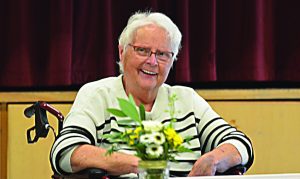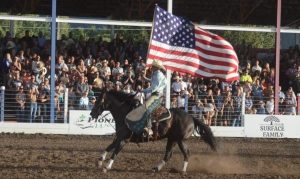Veterinarians prepare for the big race
Published 12:30 pm Friday, January 20, 2023
WALLOWA COUNTY — Just like human athletes who must undergo a rigorous examination by a doctor prior to competing, the four-legged athletes who will take part in this week’s Eagle Cap Extreme Sled Dog Race must pass their own tests.
An expected five veterinarians from Wallowa County and beyond will examine the dogs prior to and during the competition.
Trending
Randy Greenshields, DVM, has been examining sled dogs and has otherwise been involved in the Eagle Cap Extreme since its inception in 2005. He has been a veterinarian since 1994. His daughter, Brooke Greenshields, who has been a full-fledged veterinarian since 2020, will be holding down the fort at Double Arrow Veterinary Clinic while Randy is checking the sled dogs and his partner, Dr. Dave Schaefer, is out of town. Brooke has been helping out at the race for many years before completing her veterinary education.
At least one other local veterinarian, Chrissie Younggren, DVM, of Enterprise Animal Hospital, will be checking the sled dogs, as will several veterinarians from outside Wallowa County. Randy Greenshields said he expects five vets will be in Enterprise on Wednesday morning, Jan. 18, and that afternoon in Joseph.
He said they’ll have their hands full examining a total of about 175 dogs who will compete.
The race consists of:
• 200 miles: 12-dog teams (Iditarod & Yukon Quest qualifier.)
• 100 miles: eight-dog teams.
Trending
• 31-miles: Two-day, six-dog teams mid-distance race.
Body conditionThe Greenshields said when they’re examining the dogs, what they’re looking for is to make sure the animals are healthy enough and strong enough for a rigorous race.
“Basically, that they’re fit for the competition,” Randy said. “If they’re underweight, don’t have good muscling, those are reasons why we’d disqualify them.”
But it isn’t always about muscle and bones, he said.
“Even dental condition can cause problems,” he said.
In addition to the prerace examinations, there are mandatory checks at various intervals during the race.
“We check them out on the remote sites, too,” Randy said.
It’s rare, but occasionally a dog could be disqualified from participating if it’s not up to prime condition.
“We don’t like to do that, but if it’s necessary for the health and safety of the dogs, we will,” he said.
As Brooke said, it’s usually the mushers who will pull an unfit dog from the race.
“Very rarely (are dogs pulled from the race). Often the mushers will pull their dogs,” she said. “Sometimes if they’re not pulling very well and they’re tired or if they get injured. The mushers really care about their dogs.”
Ages and breedsThe Greenshields agreed the most common ages for sled dogs to compete are around 2 or 3 years old. Randy noted that he once encountered a “puppy team” of 1-year-olds and they usually age-out by the time they’re 6 or 7.
“But we’ve had some 12-year-old dogs,” he said.
They said Alaskan huskies are the most common breed — and the most successful — to be found in sled dog races, being bred for speed. Brooke said they’re actually a mix of different breeds. Brooke said they’re not bred for pulling strongly.
“People picture a Siberian or a malamute, but they’re not the best,” she said. “We often think of these big, burly dogs as sled dogs; they’re very strong, but slow. But this is a race so the marathon runners that are in really good shape are the ones that are the type of dogs that will do best. … But we’ve had German wirehairs and greyhounds mixed in to get the long legs.”
Siberian huskies and malamutes are often the least successful at racing, largely because they’re strong but slow.
“They run the same uphill as they do down,” Randy said.
Brooke agreed.
“They’re good for hauling things, like freight or medicine,” she said.
“They’re like a draft horse versus a thoroughbred,” Randy said, comparing the strong dogs to racing dogs. “They’re completely different.”
Vet qualificationsVeterinarians are not unlike medical doctors. Both study in college for eight years. However, residency requirements for vets are generally completed during the senior year in college, rather than after medical school, Randy said.
But in one sense, veterinarians have to learn more than medical doctors in that they’re caring for a variety of species.
“A cow’s not a cat,” he said.
Vet checks
Wednesday, Jan. 18: Main Street Enterprise, 9 a.m.; Main Street Joseph, 1 p.m. Members of the veterinary team will answer questions when they’re not examining dogs and talking to mushers. Leave personal pets at home.
Meet the mushers
Wednesday, Jan. 18: 6 p.m. Potluck and mushers draw for bib numbers. Cloverleaf Hall, 600 NW First St., Enterprise.
The race
Thursday, Jan. 19: Races start at noon at Ferguson Ridge Ski Area. Shuttles from parking area to the race starting line begin at 9:45 a.m. Leave personal pets at home.
Estimated finish times: The juniors’ 22-mile race and the 31-mile two-day mid-distance race should finish Thursday and Friday, late afternoon to evening. The 100-mile race is expected to end Friday morning. The 200-mile race should end early Saturday morning into the early afternoon. You can drive up to the Fergi Ski Area parking lot to watch the teams finish.
Awards reception
5:30 p.m. Saturday, Jan. 21 at Cloverleaf Hall, Enterprise.
Race Central and Kids’ Corner
Cloverleaf Hall, Enterprise. Wednesday, Jan. 18, 8 a.m. to 3 p.m.; Thursday and Friday, Jan. 19-20, 8 a.m. to 10 p.m. (closed Thursday during the start of the race). Saturday, Jan. 21, 8 a.m. to 3 p.m. Race information, treats and hot drinks, information on sled dogs and mushing, DVDs and a kids’ corner with activities, books and scheduled events.
Source: Eagle Cap Extreme website: https://www.eaglecapextreme.com/index.php/the-race/schedule









